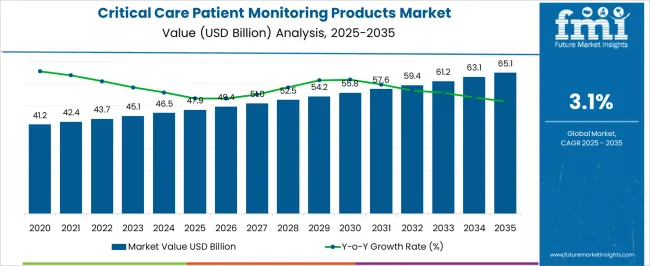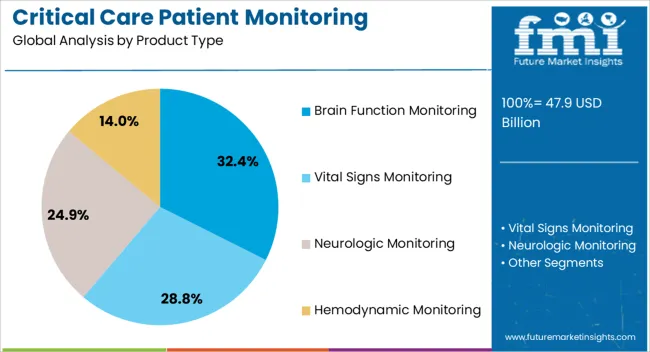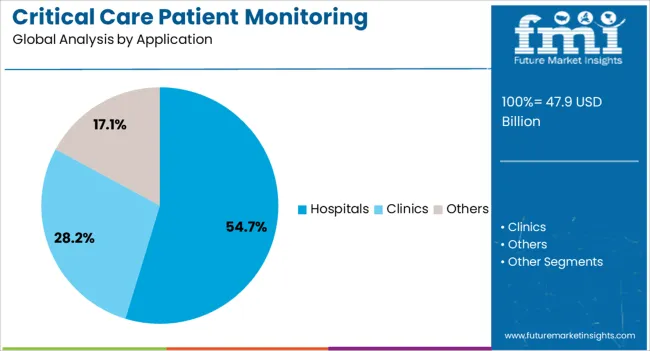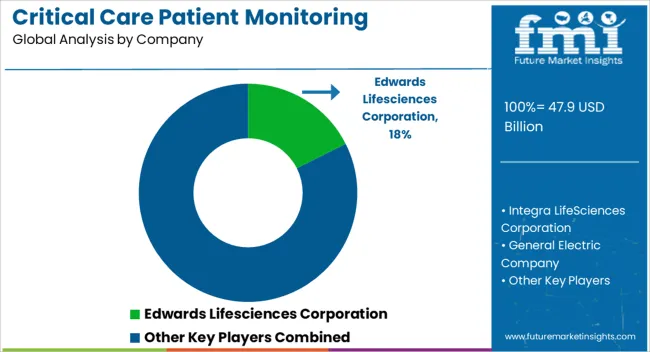The Critical Care Patient Monitoring Products Market is estimated to be valued at USD 47.9 billion in 2025 and is projected to reach USD 65.1 billion by 2035, registering a compound annual growth rate (CAGR) of 3.1% over the forecast period.
The critical care patient monitoring products market is expanding steadily due to the rising incidence of chronic and acute medical conditions, the growing elderly population, and the increasing adoption of advanced monitoring systems in intensive care units. Market development is being supported by continuous technological innovation that enhances real-time data accuracy and clinical decision-making.
Healthcare providers are prioritizing early detection and continuous monitoring to improve patient outcomes and reduce mortality rates. The integration of wireless technologies, data analytics, and AI-driven insights is transforming critical care environments by enabling efficient patient management and reducing clinical errors.
The future outlook remains positive, supported by hospital infrastructure upgrades, expanding healthcare spending, and favorable government initiatives promoting patient safety and digital health transformation Growth rationale is centered on increasing demand for precise, connected, and interoperable monitoring systems that support critical care delivery, streamline workflows, and enhance operational efficiency across global healthcare facilities.

| Metric | Value |
|---|---|
| Critical Care Patient Monitoring Products Market Estimated Value in (2025 E) | USD 47.9 billion |
| Critical Care Patient Monitoring Products Market Forecast Value in (2035 F) | USD 65.1 billion |
| Forecast CAGR (2025 to 2035) | 3.1% |
The market is segmented by Product Type and Application and region. By Product Type, the market is divided into Brain Function Monitoring, Vital Signs Monitoring, Neurologic Monitoring, and Hemodynamic Monitoring. In terms of Application, the market is classified into Hospitals, Clinics, and Others. Regionally, the market is classified into North America, Latin America, Western Europe, Eastern Europe, Balkan & Baltic Countries, Russia & Belarus, Central Asia, East Asia, South Asia & Pacific, and the Middle East & Africa.

The brain function monitoring segment, accounting for 32.40% of the product type category, has emerged as a leading product due to the rising prevalence of neurological disorders and the growing need for real-time assessment of brain activity in critical care units. Adoption has been driven by advancements in electroencephalography (EEG) and multimodal monitoring technologies that improve diagnostic precision and treatment evaluation.
Hospitals and specialty clinics are increasingly incorporating brain monitoring systems to support clinical decision-making during surgery, trauma management, and post-operative care. Continuous innovation in sensor technology, signal processing, and non-invasive monitoring is enhancing reliability and usability.
Furthermore, demand has been supported by increased awareness of neurological complications associated with critical illnesses, ensuring sustained market relevance and reinforcing the segment’s leadership position within the broader patient monitoring landscape.

The hospitals segment, holding 54.70% of the application category, has maintained dominance due to its critical role in delivering intensive and emergency medical care. The segment’s leadership is being reinforced by large-scale adoption of multi-parameter monitoring systems integrated within ICU and high-dependency units.
Hospitals have been at the forefront of adopting connected monitoring solutions that enable centralized data tracking, improve patient safety, and optimize clinician efficiency. The increasing number of critical care admissions, coupled with rising healthcare investments, has expanded the installed base of monitoring devices across both public and private healthcare institutions.
Additionally, structured procurement programs and government support for modernizing healthcare infrastructure are fostering adoption These factors are expected to ensure continued growth of the hospital segment, cementing its position as the core application area in the critical care patient monitoring products market.
Growing Focus on Data Security and Privacy is likely to Accelerate Critical Care Patient Monitoring Products Market Growth
The critical care patient monitoring products industry is being driven by a focus on data security and privacy. As healthcare organizations progressively incorporate digital monitoring tools, the security of sensitive patient data has become critical.
This focus encourages the development and implementation of advanced monitoring systems that include strong security features such as end to end encryption, secure data transfer protocols, and compliance with severe standards like as GDPR and HIPAA.
Healthcare providers and patients are more willing to trust and invest in monitoring systems that ensure data security and integrity. This trust fuels industry growth as manufacturers emphasize implementing cutting edge security features into their goods.
The surge in cyber threats and data breaches highlights the need for improved security, necessitating ongoing innovation and modifications to monitoring technology. Th critical care patient monitoring industry is growing, driven by the need for safe, dependable, and compliant monitoring systems that preserve patient data while providing high quality treatment.
Advancements in Non Invasive Monitoring Technologies to Propel Critical Care Patient Monitoring Products Industry Growth
Advancements in non invasive monitoring technologies are considerably boosting the industry growth. The developments provide healthcare workers safer, more pleasant, and efficient means of continuous patient monitoring, minimizing the need for intrusive treatments.
Non invasive equipment, such as wearable sensors and portable monitors, allow for real time monitoring of vital indicators such as heart rate, blood pressure, and oxygen levels while maintaining patient comfort.
The technologies improve patient safety by lowering the risk of infections and problems that come with invasive procedures. Non invasive monitoring technologies ease of use and accessibility enable remote monitoring and telemedicine, extending the reach of critical care services.
As healthcare systems implement the advanced technologies, demand for non invasive monitoring solutions grows, driving the critical care patient monitoring products industry.
Customized and Patient Centric Monitoring Systems to Drive Critical Care Patient Monitoring Products Market Growth
The industry is being driven by customized and patient centric monitoring systems. The personalized solutions address the specific needs of individual patients, improving the precision and efficacy of critical care. By focusing on individualized data and unique patient situations, the monitoring systems enable more accurate and prompt treatments, ultimately improving patient outcomes.
The transition to patient centered care entails creating gadgets that are not only technologically advanced, but also flexible to patients different needs.
This includes wearable and portable devices that deliver real time data, allowing healthcare practitioners to make informed decisions fast. The use of AI and machine learning in the personalized solutions improves the monitoring process by anticipating possible health concerns.
Global critical care patient monitoring products demand increased at a CAGR of 12.1% from 2020 to 2025. For the next ten years, projections are that expenditure oncritical care patient monitoring products will reach aCAGR of 13.3%.
During the historical period, the critical care patient monitoring products market grew due to the rising frequency of chronic illnesses, an aging global population, and the growing prevalence of critical care situations that necessitate advanced monitoring technologies.
The COVID19 pandemic increased demand for the products as healthcare systems throughout the world attempted to improve their critical care capacity to handle the inflow of severe patients.
This expansion will be propelled by continued advances in monitoring technology, such as the incorporation of artificial intelligence, machine learning, and Internet of Things enabled devices. The technologies are expected to increase patient monitoring accuracy, efficiency, and real time capabilities, resulting in better patient outcomes and operational efficiencies in critical care settings.
The growing use of telemedicine and remote monitoring technologies is a key driver. As healthcare practitioners discover the benefits of continuous patient monitoring outside of typical hospital settings, demand for portable and wearable monitoring equipment is expected to increase.
This is especially important in treating chronic illnesses and post operative care, where continuous monitoring can aid in the early diagnosis of problems and prompt treatments.
The increased emphasis on personalized medicine and patient centered care is driving the critical care patient monitoring products market. Advanced monitoring tools allow for individualized treatment regimens based on real time patient data, which improves care quality and patient satisfaction.
The section below covers the forecast for critical care patient monitoring product industry in terms of countries. Information on key countries in several parts of the globe, including North America, Asia Pacific, Europe, and others, is provided.
The United States is anticipated to remain at the forefront in North America, with a CAGR of 11% through 2035. In Asia Pacific, China is projected to witness a CAGR of 16.9% by 2035, leaving behind India at 15.1%.
| Countries | CAGR 2025 to 2035 |
|---|---|
| United States | 11% |
| Italy | 12.10% |
| Spain | 10.30% |
| China | 16.90% |
| India | 15.10% |
The United States, the market for critical care patient monitoring products is ushered by the surging pervasiveness of chronic disorders. Government strategies and medical care reforms notably impact the critical care patient monitoring product adoption.
The United States has a powerful presence of prominent critical care patient monitoring product vendors and modern medical care infrastructure. There is a booming trend towards the amalgamation of AI and ML in patient monitoring. Tele-ICU and its impact on critical care monitoring have gained substantial traction after the pandemic.
The aging population of Italy assists the upsurging critical care patient monitoring product demand. Italy’s healthcare system is attributed to a blend of public and private sector engagement.
Government investments and policies play a vital role in the usage of novel healthcare technologies amplifying the growth of the critical care patient monitoring product ecosystem. Italy faces impediments associated with local inconsistency in healthcare facilities and availability. There is a spurring emphasis on augmenting ICU abilities and monitoring proficiencies
The large population of China and strengthening healthcare requirements soar the rapid industry expansion. Growth in the critical care patient monitoring product industry is thrusted by large expenses in medical care technology and facilities.
The adoption of innovative monitoring technologies is simulated by the government's goal of streamlining and transforming healthcare. In rural and economically deprived regions, there is a bolstering demand for remote patient monitoring.
The section contains information about the leading categories in the critical care patient monitoring product industry. In terms of product type category, the hemodynamic monitoring segment garners a share of 46.1% by 2035. By end user category, the hospitals segmentpossesses a share of 57.2% in 2035.
| Segment | Hemodynamic Monitoring |
|---|---|
| Value Share (2035) | 46.1% |
Hemodynamic monitoring is necessary for managing critical disorders like sepsis and heart failure, prevalent in ICU settings, ushering the industry growth. The greater frequency of cardiovascular illnesses amplifies the demand for hemodynamic monitoring.
Regulatory concentration on patient security and efficient treatment agreements stimulates the demand for hemodynamic monitoring.The advancements in nonsurgical hemodynamic monitoring systems make it accessible.
| Segment | Hospitals |
|---|---|
| Value Share (2035) | 57.2% |
Hospitals witness numerous patient admission rates, soaring the demand for critical care monitoring. The hospitals are equipped with professional intensive care units that demand sustained and strengthened monitoring solutions.
Hospitals obtain relentless and intricate cases, requiring extensive monitoring to warrant patient safety. The amalgamation of modern monitoring systems in hospitals encourages adherence to strict healthcare rules and standards.
They gain advantages from better budgets and funding, authorizing investments in advanced monitoring technologies. Hospitals take part in clinical trials and research, entailing the adoption of modern monitoring devices.

The competitive edge is attributed to its intense struggle among prominent critical care patient monitoring product vendors aiming to initiate and proliferate their industry share. The critical care patient monitoring product manufacturers emphasize merging cutting-edge technologies such as AI and IoT to improve real-time monitoring and advanced analytics.
Collaborations, mergers, and acquisitions are prevalent as critical care patient monitoring product suppliers bolster their product portfolios and global footprint. Industry dynamics are impacted by boosting medical care requirements, technical breakthroughs, and the continuous demand for streamlined critical care management solutions.
Industry Updates
| Company | Honeywell |
|---|---|
| Headquarter | United States |
| Recent Advancement | In April 2025, Honeywell launched a real-time health monitoring system that registers and observes patients' vital signs in person as well as remotely in hospitals. With Honeywell's strategy, a skin patch is utilized to track signs using modern sensor technology. |
| Company | Aerobiosys Innovations Private Limited |
|---|---|
| Headquarter | India |
| Recent Advancement | Aerobiosys Innovations Private Limited, an Indian start-up from IIT Hyderabad, launched Jeevan Lite, an IoT-enabled ventilator, in March 2025. Its main goal is to make critical care affordable and accessible. |
| Company | Critical Care Hope |
|---|---|
| Headquarter | India |
| Recent Advancement | In March 2025, Critical Care Hope declared that it obtained a USD 400K investment from SAMRIDH Healthcare Blended Financing Facility to scale up its technologically-enabled tele-ICU platform in the Indian states of Rajasthan, Haryana, Punjab, Uttar Pradesh, and Madhya Pradesh. |
The ecosystem is classified into brain function monitoring, vital signs monitoring, neurologic monitoring, and hemodynamic monitoring.
The industry is trifurcated into hospitals, clinics, and others
Analysis of the sector has been carried out in key countries of North America, Latin America, East Asia, South Asia and Pacific, Western Europe, Eastern Europe, and the Middle East and Africa.
The global critical care patient monitoring products market is estimated to be valued at USD 47.9 billion in 2025.
The market size for the critical care patient monitoring products market is projected to reach USD 65.1 billion by 2035.
The critical care patient monitoring products market is expected to grow at a 3.1% CAGR between 2025 and 2035.
The key product types in critical care patient monitoring products market are brain function monitoring, vital signs monitoring, neurologic monitoring and hemodynamic monitoring.
In terms of application, hospitals segment to command 54.7% share in the critical care patient monitoring products market in 2025.






Full Research Suite comprises of:
Market outlook & trends analysis
Interviews & case studies
Strategic recommendations
Vendor profiles & capabilities analysis
5-year forecasts
8 regions and 60+ country-level data splits
Market segment data splits
12 months of continuous data updates
DELIVERED AS:
PDF EXCEL ONLINE
Critical Power and Cooling Market Size and Share Forecast Outlook 2025 to 2035
Critical Infrastructure Protection Market
Critical Infrastructure Monitoring Market
Critical Care Diagnostics Market Size and Share Forecast Outlook 2025 to 2035
Critical Care Drugs Market Analysis – Trends, Demand & Forecast 2024-2034
Critical Care Information Systems Market
Supercritical Fluid Chromatography Market
LTE & 5G for Critical Communications Market Size and Share Forecast Outlook 2025 to 2035
Suncare Products Market Size and Share Forecast Outlook 2025 to 2035
Skincare Supplement Market Size and Share Forecast Outlook 2025 to 2035
Skincare Oil Market Size and Share Forecast Outlook 2025 to 2035
Lip Care Market Analysis - Size and Share Forecast Outlook 2025 to 2035
Skincare Nutritional Serum Market Size and Share Forecast Outlook 2025 to 2035
Haircare Supplement Market - Size, Share, and Forecast Outlook 2025 to 2035
Lip Care Packaging Market Size and Share Forecast Outlook 2025 to 2035
Skincare Market Analysis - Size, Share, and Forecast Outlook 2025 to 2035
Skincare Packaging Market Size, Share & Forecast 2025 to 2035
Pet Care Market Analysis – Demand, Trends & Forecast 2025–2035
Pet Care Packaging Market Insights - Growth & Forecast 2025 to 2035
Eye Care Supplement Analysis by Ingredients, Dosage Form, Route of Administration, Indication, Distribution channel and Region 2025 to 2035

Thank you!
You will receive an email from our Business Development Manager. Please be sure to check your SPAM/JUNK folder too.
Chat With
MaRIA